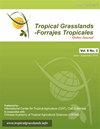银乳系统下大菱鲆基因型的解剖和营养特性
IF 0.7
4区 农林科学
Q3 AGRICULTURE, DAIRY & ANIMAL SCIENCE
引用次数: 3
摘要
我们的目的是测量5种巨巨猴(megthyrsus maximus, syn. Panicum maximum)基因型的化学成分和解剖结构,这些基因型与桉树在一个银园系统中结合生长。在距桉树行5个不同距离的全光照和银寄生系统下,对马塞、蒙巴帕拉、BRS、塔玛尼、坦桑尼亚和种内杂交种PM44进行了评价。试验设计为2个重复的分割区随机区组。图对应于基因型,亚图对应于系统内的采样点。测定了总饲料量、叶片生物量、营养价值和组织比例。我们的研究结果表明,随着辐射照射的减少,生物量减少。饲草生物量以BRS Tamani和monbaa最高,PM44最低。粗蛋白质、有机物体外消化率、纤维素、半纤维素和木质素s等营养价值变量与基因型之间存在显著的交互作用,而组织比例不受基因型与采样点的交互作用影响。基因型对化学成分和解剖特征的影响比采样点的影响更显著。蒙巴拉达的叶片最长,总横截面积最大,其厚壁组织和维管组织的比例高于其他品种,叶肉组织的比例最低。薄壁组织束鞘的比例也最大。PM44和tanzania基因型的厚壁组织比例最低,PM44和BRS Tamani基因型的维管组织比例最低。另一方面,PM44和坦桑尼亚的叶肉比例最大。BRS Tamani与最常用的品种mombaa和tanz本文章由计算机程序翻译,如有差异,请以英文原文为准。
Anatomical and nutritional characteristics of Megathyrsus maximus genotypes under a silvopastoral system
Our objective was to measure chemical composition and anatomy of 5 Megathyrsus maximus (syn. Panicum maximum) genotypes, when grown in combination with eucalypts in a silvopastoral system. Cultivars Massai, Mombaça, BRS Tamani, Tanzânia and intraspecific hybrid accession PM44 were evaluated in full sun and a silvopastoral system at 5 different distances from eucalyptus tree rows. The experimental design was a randomized block in split plot with 2 replications. Plots corresponded with genotypes and subplots with sampling points within the system. Total forage and leaf biomass as well as nutritive value und tissue proportions were evaluated. Our results showed a decrease in biomass as radiation incidence decreased. Forage biomass was greatest in BRS Tamani and Mombaça and lowest in PM44. There was a significant interaction between sampling points and genotype for nutritive value variables, such as crude protein, in vitro digestibility of organic matter, cellulose, hemicellulose and lignin-S, while tissue proportions were not affected by the interaction between sampling points and genotypes. Genotype had more pronounced effects on chemical composition and anatomical characteristics than did sampling points. The leaves of Mombaça were the longest and had greatest total cross-sectional area, and this genotype showed greater proportions of sclerenchyma and vascular tissues than other cultivars and the lowest proportion of mesophyll. The greatest proportion of parenchyma bundle sheaths was also found in Mombaça leaves. Genotypes PM44 and Tanzânia had the lowest proportions of sclerenchyma, and PM44 and BRS Tamani had the lowest proportions of vascular tissues. On the other hand, PM44 and Tanzânia had the greatest proportions of mesophyll. BRS Tamani was comparable with the most used cultivars, Mombaça and Tanzânia, and had forage quality slightly superior to that of Mombaça. Tropical grasses growing under shade can potentially produce less forage but with better nutritive value, in terms of chemical composition and tissue proportions, than grasses grown under full sun. However, as the degree of shading in silvopastoral systems does not occur uniformly across the whole area, the improved nutritive value would not be uniform and may not be very prominent overall.
求助全文
通过发布文献求助,成功后即可免费获取论文全文。
去求助
来源期刊

Tropical Grasslands-Forrajes Tropicales
Agricultural and Biological Sciences-Agronomy and Crop Science
CiteScore
1.60
自引率
0.00%
发文量
36
审稿时长
16 weeks
期刊介绍:
The Journal publishes, in English or Spanish, Research Papers and Short Communications on research and development, as well as contributions from practitioners (Farmer Contributions) and Review Articles, related to pastures and forages in the tropics and subtropics. There is no regional focus; the information published should be of interest to a wide readership, encomprising researchers, academics, students, technicians, development workers and farmers.
In general, the focus of the Journal is more on sown (''improved'') pastures and forages than on rangeland-specific aspects of natural grasslands, but exceptions are possible (e.g. when a submission is relevant for a particularly broad readership in the pasture and forage science community).
The Journal will also consider the occasional publication of associated, but closely related, research in the form of an additional scientific communication platform [e.g. a re-make of the former Genetic Resources Communication series of the former Division of Tropical Crops and Pastures of the Commonwealth Scientific and Industrial Research Organisation (CSIRO), Australia].
Areas of particular interest to the Journal are:
Forage Genetic Resources and Livestock Production[...]
Environmental Functions of Forages[...]
Socio-economic Aspects[...]
Topics within the aforementioned areas may include: Diversity evaluation; Agronomy; Establishment (including fertilization); Management and utilization; Animal production; Nutritive value; Biotic stresses (pests and diseases, weeds); Abiotic stresses (soil fertility, water, temperature); Genetics and breeding; Biogeography and germplasm collections; Seed production; Ecology; Physiology; Rhizobiology (including BNF, BNI, mycorrhizae); Forage conservation; Economics; Multilocational experimentation; Modelling.
 求助内容:
求助内容: 应助结果提醒方式:
应助结果提醒方式:


